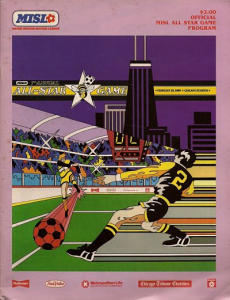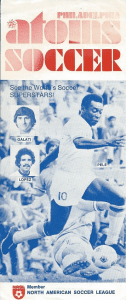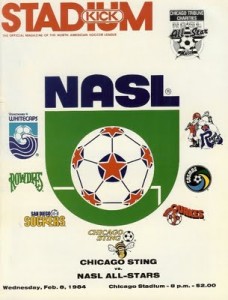Recently, Fun While It Lasted had the pleasure of speaking to long-time sports executive Doug Verb for the latest entry in our Promoters Series.
Doug was one of the founding executives behind the Major Indoor Soccer League and the Arena Football League and served as President of the Chicago Sting soccer club from 1982 to 1986.
The Temple University grad has developed and consulted on sales promotions, event management and television deals for major sports and entertainment properties including the NBA, the Miss America Organization and numerous promotions in his home base of Las Vegas, Nevada. Doug’s company Action Sports America (www.giantjersey.com) is a promotional consultant and supplier to major and minor professional sports teams.
I asked Doug for 20 minutes of his time and came away with nearly two hours of great stories about the boom & bust years of American pro soccer in the late 1970’s and early 1980’s.
I hope you enjoy the highlights of our conversations below. You can download the entire interview here.
##
FWiL:
How did you break into pro sports, Doug?
With the 1976 Philadelphia Atoms of the North American Soccer League. We were the worst professional franchise in America, and I think we may still hold the title to this day.
We had a lot of the same problems that other teams had. We were terrible on the field. There was no money for marketing. We had a terrible schedule – if it was Easter Sunday or Mother’s Day or the 4th of July, that meant the Atoms had a home game. And we had absentee owners. The Atoms were owned by the four 1st Division teams in Guadalajara, Mexico.
Like I said, lots of soccer teams had those problems back then. But we also had a problem that nobody else had: no one on the Atoms spoke English and we played in Philadelphia, Pennsylvania.
FWIL:
You were the Chivas USA of your day!
Doug Verb:
Well, yeah, but it wasn’t set up that way! We didn’t quite have a Hispanic market in Philadelphia. We couldn’t even find a place for the guys to eat.
The local President of the Atoms was an American named Ed Tepper. Ed previously owned the Philadelphia Wings indoor lacrosse team that played at the Spectrum. Somebody recommended me to Ed to be the Atoms’ PR Director. After two or three days on the job, I went to see Ed Tepper and said ‘Ed, why are we doing this?’
Ed says ‘We’re doing this to learn about soccer. We’re gonna do indoor soccer.’
The day the Mexicans got off the plane in Philadelphia, I took them right to the Spectrum. There’s no translator. I brought them out onto an Astroturf carpet that didn’t quite fit over the hockey rink. These guys clearly think that they’re just in this building to loosen up and see the locker rooms – Veterans Stadium was right next door.
I tell them “No, we’re playing a game here a las siete, at seven o’clock.”
They went back to the locker room and said no, no, no, they’re going home. So I took what they thought were their plane tickets home and I just stood in the middle of the locker room and ripped them up. Of course, it was just their receipts. I kept hearing them call me ‘Loco! Loco Verb-o!’ while I’m trying to explain indoor soccer – that it’s only five players on the field and just try it, it’s going to be fun.
And so they played an indoor exhibition that night against some local semi-pros and they did have fun. I think we had five or six thousand people in the Spectrum and afterwards I told Ed Tepper ‘There is something to this’. Indoor was fast and fun and exciting.
Anyway, then we moved outdoors and had a horrible year. The Mexicans had never seen Astroturf before. The NASL was mostly a league of English guys and our undersized players just got pounded into the turf week after week by the English players. We played on Bicentennial weekend and nobody came. I announced the attendance as 1,776. And the worst part of it all was that only one of these players ever went back and played professionally in Mexico.
So the Atoms went away. I went back to sports writing. And then two years later I got a call from Ed and another guy named Earl Foreman.
FWiL:
The founders of the Major Indoor Soccer League (MISL).
Doug Verb:
Yes. I was one of the four guys that started the MISL, along with Ed, Earl and a Ph.D from the University of New Haven named Joe Machnik, who was the soccer guy.
After the Atoms folded, I worked for The Trenton Times. I covered soccer in Philly and New York including the New York Cosmos. The Times was owned by The Washington Post so occasionally my Cosmos stories got picked up by the national Post news service.
Ed called on my birthday. Friday the 13th of October 1978. The other guy on the phone was Earl Foreman. Earl was the closest guy that I ever met to a genius. But also on that fine line of being maniacal. Earl was a big-time lawyer. He had a lot of sports experience as an owner in the American Basketball Association, where he’d signed Julius Erving out of college, as a part owner of the Eagles, and with the old Washington Whips soccer team. His brother-in-law was Ed Snider who owned the Flyers and Earl restructured the lease for the Flyers and made the Spectrum into the country’s #1 arena. Ed Tepper convinced Earl that indoor soccer was the way to go.
They said we have this idea of Americanizing soccer. Why don’t you come over and we’d like to talk to you about how the media will look at it?
“I don’t need to come by. I’ll tell you right now. They’ll ignore you. They’ll hate you. Sports editors hate it. They don’t like soccer. The only reason I get to write a little here is because it’s the Cosmos.”
I had to cover a New Jersey Nets game that night, so I told them I had to go and I went to take a nap. The phone rang a few hours later and it was Ed and Earl again.
“We got our sixth team and we’re ready to start.”
I said “Start what?”
I started working for the MISL two days later on October 15, 1978. The only known piece we had going for us was Pete Rose, who was a part-owner of our Cincinnati Kids franchise. Pete was great. He was on his free agency trail, which was relatively new back then. I went on the road with Pete as he met with Major League teams in all of the six cities we had for the league. Pete drew throngs of reporters and he always made it a point to talk to the press about indoor soccer.
We launched the league in 69 days. We played our first game on December 22nd, 1978 with Pete Rose kicking out the first ball at the Nassau Coliseum.
Putting together the league in the fall of ’78 was like getting my Master’s degree in the sports business. The Ph.D. came when Earl Foreman said ‘Look. When we get a new franchise, you need to go there, whether it’s for the first two weeks or two months and make sure we stay away from the ‘Brother-in-Law effect’”.
Sure enough, we go into Wichita, Kansas for the first round of expansion in 1979. So Joe Machnik and I went to Wichita to meet with the <new owner>. And Joe asks ‘What about the soccer operations side?’
And of course this guy says ‘Oh, I’ve got that covered. My brother-in-law has been involved in youth soccer here in Wichita for seven years.’
I started laughing and Joe kicked me under the table. Joe told him ‘Look, this is a professional organization. I have list for you of coaches and general managers with experience in pro soccer.’
And the guy is heartbroken. He’s thinking what am I going to tell my wife?
FWiL:
Let’s talk about the Chicago Sting.
Doug Verb:
After five years in the MISL league office I wanted to go run a franchise. I was hired to be the President of the Chicago Sting. This was 1982. The Sting were playing soccer year-round – outdoors and indoors – in the North American Soccer League.
My guy in Chicago was Lee Stern. He was everything that was great about soccer in Chicago. He built the foundation of soccer in that town. Because of his stick-to-itiveness and his willingness to absorb what I’d estimate to be $20 million in losses over about 15 years of owning the Sting. The Sting won a couple of titles and had a big championship parade down LaSalle Street when they won the Soccer Bowl in 1981, just like the big boys did.
And yet, Lee was everything that was wrong with owners as well.
Lee would call sports editors at 2:30 in the morning and want to know why the Sting were on the second page when we’d just won a playoff game. When I got there I said to Lee ‘<The editors> all think you’re an asshole.’
And he looked at me like ‘What do you mean?’
‘No one’s ever told you this?!’
‘No!’
Once I’d been there for a little while, I realized why people weren’t being straight with him. In the early years, it was all soccer guys running the Sting. And they were all stealing from Lee. Coaches would do player deals and they’d get a piece of it on the back end. That was the way in soccer back then. The soccer guys did the equipment deals too and they were a joke. We got hardly any money from Adidas. Well, the coach was selling the equipment! Not out of the back of his car, but out of a friend’s car.
FWiL:
Who were some of the most memorable characters on those Sting teams?
Doug Verb:
Karl-Heinz Granitza was the man. He was suave and European. He was a man about town. He had limitations in his game. He wasn’t fast, he wasn’t quick. He kind of played a post-up game and he scored a lot of goals that way. He also had a trendy restaurant and some other business ventures, but he ended up leaving a lot of paper around town and he had to eventually just leave Chicago a few years after the Sting ended. It was a lot of money.
Pato Margetic was a scrawny half-German half-Argentine guy with wild blond hair. He reminded me of an indoor soccer version of Pete Maravich. He was a guy who got the ball on his foot and the crowd just stood up. I never had anything to do with player contracts, except for Pato’s. Pato wanted more money and wanted to stay in Chicago, so I got involved with his contract. We made him a model for one of our sponsors who made blue jeans to get him the extra money.
And then there were the Americans. The leader was Rudy Glenn who was from one of the Chicago suburbs and played at the University of Indiana. He was a big strong defender and he did more camps and clinics than anyone else.
In 1984 we signed a kid named Frankie Klopas who was 16 or 17 years old and underage. He went to Mather High School in Chicago, but he was born in Greece. There’s a big Greek community in Chicago. After we signed Frankie, I couldn’t walk into a Greek restaurant in Chicago – from Greektown to all the little hamburger joints – without them clearing a table for me and never letting me pay. And, of course, I didn’t have anything to do with signing him. Frankie went on to become a national team player for the U.S.
FWiL:
What was the impact on the Sting on bouncing around between Wrigley, Comiskey and Soldier Field every year? Why couldn’t the team settle in one place?
Doug Verb:
The impact was that even the players got confused and would go to the wrong stadium on the wrong day. So how could the fans possibly know where we were playing?
The two baseball teams didn’t want us at all. Lee Stern was a part-owner of the White Sox and he just kind of imposed his will to play at Comiskey. The White Sox were at least very cordial to us. But when I walked into Wrigley for the first time, the Cubs made it very obvious that we weren’t wanted there. Mainly for the reason of ‘you’re going to chew up the field’, which never happened.
And Soldier Field was just too big. They were all too big. We put all the fans on the TV side, so one time (coach) Willy Roy’s sons sat all alone in a huge section of empty seats. We had them hold a sign saying “Willy Roy’s Fan Club”
That was the pre-soccer specific stadium era, so everyone faced the same problem. Now my belief is that is not what kept the crowds down for the Sting outdoors. It was just the game of outdoor soccer. It just wasn’t in the blood here. Lots of kids were starting to play soccer but here’s the analogy I’ll make: Everybody bowls. But how many go to see a PBA bowling event?
And again, the Sting were exciting and high-scoring and the players were known and did all sorts of camps and clinics. I used to say to Lee Stern ‘Let’s do All-Star Games, international matches, camps and clinics and merchandise’. But forget all these year-round league games.Those we lose money on.
Lee’s response was “What am I going to do? Buy a bigger boat to take down to Florida?”
FWiL:
What did the economics of the Sting look like?
The second year I was there, Lee called me and said ‘Kid, you did great. The numbers came in. You lowered the loss to a million dollars.’
The loss had been $1.7 million a year when I got there. I said ‘Oh. OK. If you’re happy that’s great. I’m not happy. I want us to make money.’
Lee says ‘I want to bonus you. I just bought you a unit of soybeans.’
Lee was a commodities broker. That’s how he made his money.
‘What does that mean?’ I asked.
‘Don’t worry, they’re not going to back a truck of beans up to your house. I’ll take care of you.’
The next day Lee calls and says ‘Kid, you’re out of the soybeans. I sold your unit.’
‘You did? Why?’
‘I put the $5,000 in your account.’
‘What do you mean?’
‘I bought them at one price, I sold them at another. You made 5 Gs.’
So, of course I said ‘Thanks! Can we do it again tomorrow?’
‘No, kid. It’s not that easy.’
FWiL:
In 1984, the North American Soccer League folded the day after the Sting won the league’s final Soccer Bowl championship. The Sting moved indoors permanently after that. What are your memories of that time?
Doug Verb:
Three weeks after we won the last Soccer Bowl, we were back playing indoor soccer at Chicago Stadium. We had joined the MISL when the NASL folded.
Indoor soccer was a show. We’d turn out the lights and introduce the team to Aaron Copland’s Fanfare for the Common Man. Everybody would go crazy. That fan experience was new at the time. Something we started at the MISL.
40% of our indoor fans were women, which was very unusual at the time. They loved the players – these were average-sized guys running around in their underwear. Once the players figured that out, they’d start greasing up their legs. I’ll never forget – I had a woman come up to me who said ‘give me those two seats right there next to the bench and I’ll give you a hundred dollars a ticket.’ I think those tickets were $25 at the time.
FWiL:
What led to the end of the Sting? Was it the move to the Rosemont Horizon in 1986?
Doug Verb:
Well, I initiated the talks with the Horizon. Because it was the suburbs.
But I loved the old Chicago Stadium. How could you not? It was an incredible building. I never heard from anybody who said ‘oh no, I won’t go down there’. But I did start looking at it because we had so many fans out in the suburbs. My plan was to play maybe four or five games a year at the Horizon and continue to play the rest of the schedule at Chicago Stadium. I knew there could be some issues for indoor soccer at the Horizon.
 We hosted the MISL All-Star Game at Chicago Stadium in February 1986. The day after that game I quit/was fired. Lee and I had just had enough of each other. My replacement committed to play the entire 1986-87 season at the Horizon, which I never would have done.
We hosted the MISL All-Star Game at Chicago Stadium in February 1986. The day after that game I quit/was fired. Lee and I had just had enough of each other. My replacement committed to play the entire 1986-87 season at the Horizon, which I never would have done.
The biggest issue we, the front office, encountered was our coach Willy Roy. And I never tried to get rid of him. Willy had won Lee two Soccer Bowl titles in the NASL. But Willy would not learn indoor soccer. Remember, an outdoor coach does nothing during a game. Limited number of substitutions, can’t really call plays. Just sits there – maybe yells at a referee once in a while. Willy was great at finding talent and he trained the players hard. But for whatever reason, he would never learn the nuances of the indoor game
In contrast to a guy like Kenny Cooper, the coach of the Baltimore Blast. Kenny was English and he went to ice hockey coaches to learn about shift changes and power plays. He said ‘what’s this about going in one door and out the other’? Willy couldn’t get his players to come off the field for shift changes. Time after time we’d get beat because other teams would go on fast breaks and Willy couldn’t get his players in and out of the door!
We had the best talent, at least as good as anyone in league, with great crowds behind us. But we couldn’t get out of the first round of the playoffs. And in the MISL, that’s where you made your gravy. Playoff revenue was all yours to keep. If we would have had 5 or 6 playoff games instead of 1-2, we would have come pretty damn close to breaking even.
Who knows what might have happened if I had gotten rid of Willy and hired someone who was an indoor coach? Camps were great, we finally had sponsors paying the right amount for sponsorships and we’d put together a small TV network throughout the Midwest of Sting games that was getting decent ratings. We might not still be alive — because there’s not major market indoor soccer anymore — but we had things cooking.
And I had the time of my life. It sure was fun while it lasted.
Links
Doug Verb Full Interview Transcript
Doug’s Website – Action Sports America
More Interviews from the Promoters Series
##




3 Responses
tremendous @AMCrossley interview w/ minor league BB exec Doug Verb re: #ChicagoSting original #NASL #MISL http://t.co/CS3OiOtTyk
Just saw this great interview of ex @Chicago_Sting Prez Doug Verb by @AMCrossley for Fun While It lasted. Fantastic: http://t.co/v64jThRJUM